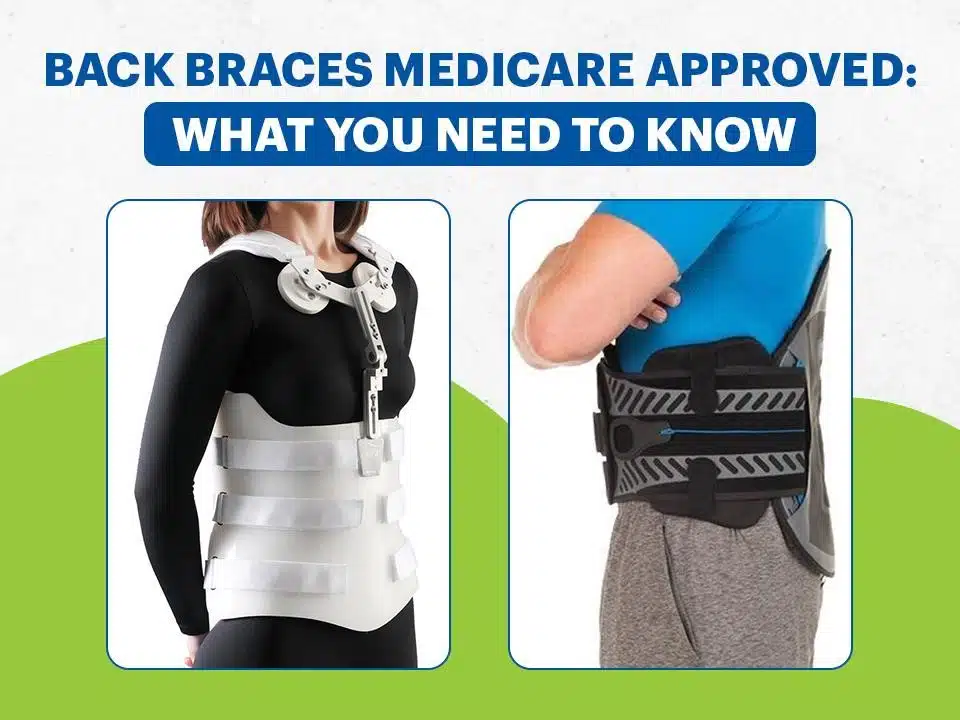Back pain is a common ailment that can affect people of all ages, from young adults to seniors. Various factors, including injuries, chronic conditions, or natural aging, can cause it. Regardless of origin, seeking relief and support for back pain is a universal concern. Fortunately, there’s a practical solution available in the form of Medicare-approved back braces. In this comprehensive guide, we’ll delve into the world of back braces, uncovering their numerous benefits, explaining the eligibility criteria for Medicare coverage, and providing step-by-step guidance on obtaining one. Whether you’re a younger individual grappling with back pain or a senior seeking comfort and stability, this guide will equip you with the knowledge to make informed decisions about managing your back pain effectively.
Understanding Back Pain
Back pain is a common and often debilitating condition that can profoundly impact an individual’s quality of life. It can stem from various causes, including injuries sustained during accidents or sports activities, muscle strains resulting from overexertion, herniated discs that press on nerves, or underlying medical conditions such as arthritis or spinal disorders. Regardless of the specific cause, the experience of back pain can be distressing, limiting one’s ability to perform routine daily activities and affecting overall well-being.
The Role of Back Braces
Back braces are essential medical devices meticulously crafted to provide critical support, enhance stability, and offer much-needed pain relief for individuals grappling with back pain. These braces are ingeniously designed to reduce excessive muscle strain, support the spine, correct posture, and promote the alignment of the spinal column. Whether you’re dealing with acute pain from an injury, chronic discomfort due to a medical condition, or simply striving to maintain proper spinal health, back braces can play a pivotal role in your journey to recovery and enhanced quality of life.
Benefits of Medicare-Approved Back Braces
The benefits of Medicare-approved back braces extend far beyond their role as mere supportive devices. These specially designed braces serve as invaluable tools for eligible beneficiaries to address the challenges posed by back pain. Here, we delve into the key advantages of these braces, shedding light on their remarkable capacity to enhance the lives of individuals grappling with back-related discomfort:
- Pain Relief: One of the most immediate and impactful benefits of Medicare-approved back braces is their ability to provide targeted compression and support. By gently but effectively cradling the back, these braces alleviate the pain and discomfort commonly associated with various back conditions. Whether you’re dealing with the throbbing ache of a herniated disc, the persistent soreness from muscle strain, or the nagging discomfort of spinal misalignment, a properly fitted back brace can provide much-needed relief.
- Improved Mobility: Back pain often translates to reduced mobility, limiting your ability to engage in everyday activities and enjoy life to the fullest. With the reliable support of a Medicare-approved back brace, individuals can experience a significant improvement in their mobility and flexibility. These braces work diligently to alleviate the strain on your back muscles, facilitating smoother movements and making it easier to perform daily tasks without hesitation.
- Posture Enhancement: Proper posture is critical for spinal health but can be challenging when dealing with back pain. Back braces come to the rescue by providing the necessary support to align your spine. They reduce the strain on your spine and surrounding muscles, helping you maintain correct posture throughout your daily activities. This eases discomfort, prevents further damage, and promotes overall spinal health.
- Non-Invasive Solution: Back pain can sometimes be severe enough to warrant surgical intervention, but not everyone is a candidate for such procedures, and surgery can be daunting. Here, Medicare-approved back braces offer a valuable non-invasive alternative. You can effectively manage your back pain without surgery by opting for a back brace. This can be especially reassuring for individuals who prefer to explore less invasive options before considering surgical measures.
Eligibility for Medicare Coverage
Navigating the healthcare landscape can sometimes feel like a labyrinth, but there are clear pathways to eligibility for Medicare-approved back braces. To ensure that you can access the support you need, it’s vital to meet specific criteria. Here’s a breakdown of the key requirements:
- Be a Medicare beneficiary: The first checkpoint on the road to Medicare coverage for a back brace is your status as a Medicare beneficiary. To be eligible, you should already be enrolled in Medicare Part B. Part B covers various medical services and durable medical equipment, including back braces. If you’ve met this initial requirement, you’re on the right track.
- Have a prescription: While being a Medicare Part B beneficiary is a significant step, it’s not the sole criterion. You’ll need a prescription from a qualified healthcare provider to secure coverage for your back brace. This prescription is more than a formality; it’s a crucial document specifying the back brace’s medical necessity. In other words, your healthcare provider must determine that a back brace is essential for addressing your specific back condition or pain.
Choosing the Right Back Brace
Selecting the appropriate back brace is essential for effective pain management. Here are some considerations:
- Consult a Healthcare Provider: Your journey to finding the perfect back brace begins with a conversation with your healthcare provider. They possess the expertise to evaluate your specific back condition and recommend the type of brace that will be most effective for you. Your healthcare provider’s guidance is invaluable in this decision-making process.
- Comfort and Fit: Comfort is key when it comes to back braces. A well-fitted brace provides optimal support without causing discomfort or skin irritation. Ensure the brace conforms to your body’s contours and doesn’t dig into your skin. Comfortable wear encourages compliance and long-term use.
- Adjustability: The human body is dynamic, and your back’s support needs may change. Look for a back brace with adjustable features like straps or closures. These allow you to customize the level of support as needed, ensuring a snug fit that adapts to your comfort requirements.
- Material and Breathability: Consider the brace’s material and breathability. Opt for a brace made from breathable materials that wick away moisture and allow air circulation. This prevents excessive sweating and reduces the risk of skin irritation during extended wear.
- Activity Level: Your lifestyle and activity level play a significant role in choosing the right back brace. Some braces are designed for daily wear and provide ongoing support for chronic conditions. Others may be more suitable for specific activities or recovery following surgery or injury. Discuss your activity level with your healthcare provider to determine the most appropriate brace for your needs.
The Medicare Coverage Process
Navigating the process of obtaining a Medicare-approved back brace may seem daunting, but understanding each step can simplify the journey. Here’s a breakdown of the essential stages:
- Medical Evaluation: Your first step is to consult your trusted healthcare provider. They will evaluate your back condition thoroughly, considering factors such as the nature and severity of your pain, medical history, and previous treatments. Based on their assessment, your healthcare provider will determine whether a back brace is medically necessary to alleviate your condition.
- Prescription: If your healthcare provider deems a back brace necessary for your treatment, they will provide a prescription. This prescription serves as a crucial document in the process, indicating to Medicare the medical necessity of the brace. It specifies your unique needs and the type of back brace required.
- Supplier Selection: Once you have your prescription in hand, you’ll need to choose a supplier approved by Medicare to provide durable medical equipment, including back braces. It’s essential to select a reputable and reliable supplier who can ensure the quality and suitability of the brace for your condition.
- Documentation: Accurate and complete documentation is vital for a smooth approval process. Ensure you have all the necessary paperwork, including your prescription and relevant medical records, to support your claim. A well-organized documentation file helps prevent delays and ensures Medicare has all the information needed to assess your case.
- Claim Submission: Your chosen supplier will assist you in submitting the claim for your Medicare-approved back brace. This step involves providing all the required documentation to Medicare for review. Working closely with your supplier is essential to ensure the claim submission is accurate and timely.
Read More: How to Get Medicare Coverage for Back Braces: Step-by-Step
Caring for Your Back Brace
Proper maintenance and care of your back brace are essential for its longevity and effectiveness. Here are some tips:
- Regular Cleaning: Over time, your back brace may accumulate dirt, sweat, and bacteria. To prevent unpleasant odours and maintain hygiene, clean your brace regularly. Follow the manufacturer’s guidelines for cleaning, which typically involve using mild soap and water. Be sure to rinse and dry it thoroughly before wearing it again.
- Inspection: Periodically inspect your back brace for any signs of wear and tear. Check the straps, closures, and movable parts to ensure they function correctly. If you notice any damage or malfunction, contact your supplier promptly for necessary repairs or replacements.
- Skin Protection: Wearing a back brace for extended periods can sometimes lead to skin irritation or chafing, especially in hot or humid conditions. To protect your skin, consider wearing a moisture-wicking undershirt beneath the brace. This can help reduce friction and discomfort while maintaining skin health.
- Follow Instructions: Every back brace comes with care instructions from the supplier or manufacturer. These instructions are tailored to your specific brace and are essential to follow. They may include guidance on cleaning, storage, and general maintenance. Adhering to these instructions ensures the longevity and effectiveness of your back brace.
Conclusion
In conclusion, a Medicare-approved back brace can significantly improve the quality of life for individuals suffering from back pain. Understanding eligibility criteria, benefits, and the selection process is crucial in obtaining the right brace for effective pain management. By following proper care and maintenance, you can maximize the comfort and longevity of your back brace, helping you lead a more pain-free and active life.









